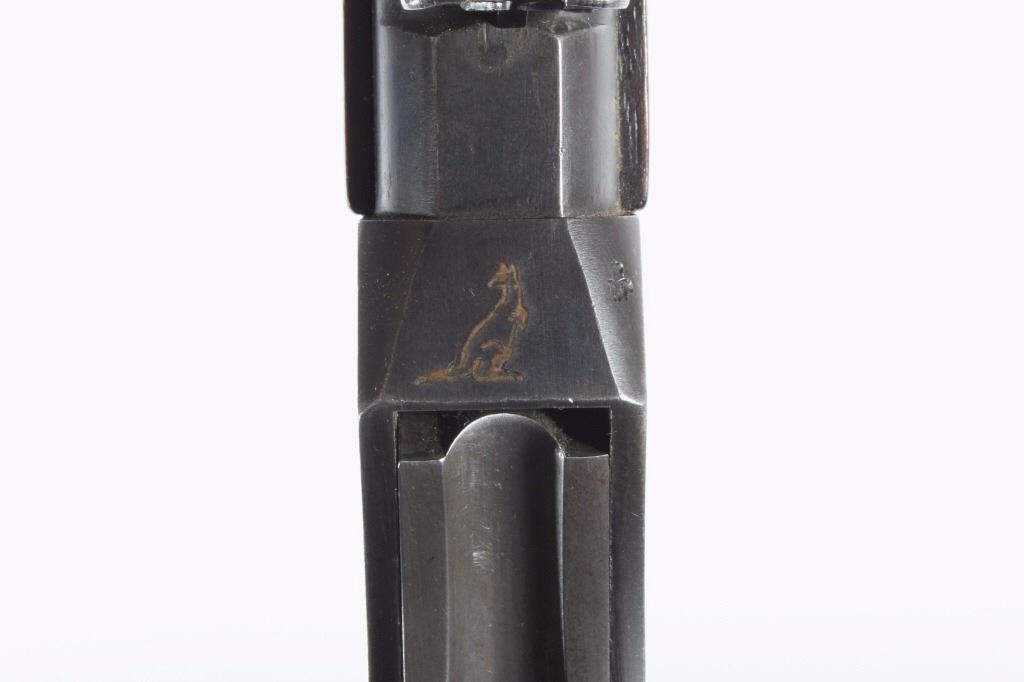For a lot of us it might seem curious that we used to get firearms imported from Australia. The first I had encountered, the “Tasmanian Devil,” made for quite the review back in May of last year. The second couldn’t be any different yet remains every bit as interesting, from the adorable kangaroo engraved on top of the receiver to its history. Let’s take a look at the Greener Martini Cadet.
It’s worth noting that the Martini Cadet was in fact produced in the United Kingdom by BSA and W.W. Greener, though it was destined to be used by Australian military Cadets as trainers. In principle the Cadet is a scaled down Martini-Henry with some internal redesigns. Used between 1891 to 1955 it was natively chambered for the .310 Cadet (aka .310 Greener) cartridge but was later made available to the public in calibers such as the .297/230 and .22 rimfire. These versions were marked as the BSA No.4, 4a, 4b, and 5. Apparently the .32-20 Winchester would often drop into these actions but slight differences in bore diameter would result in questionable accuracy. Approximately 83,000 Martini Cadets were produced up until 1949.
Once the Australian government sold off their .310 chambered Cadet rifles they were often converted for cartridges such as the .22 Hornet, .218 Bee, .25-20 Winchester, .222 Rimmed, and .357 Magnum. As luck turned out, the .357 is what I had a chance to handle.
The controls of a Martini Cadet couldn’t be more simple. There’s a lever which opens the falling block action and permits access to the chamber. Thumb in a single round, close the action, then take the shot. I couldn’t see any other controls besides the action lever and trigger, not even a safety.
If you want to be technical this version also had a fully adjustable rear peep sight threaded onto the back left of the receiver so there’s controls for windage and elevation. I believe the sliding ramp rear sights are more common with the peep sights having been an option back in the day. Regardless, a Cadet rifle is a compact and very comfortable six pounds and five ounces and is easy to bring onto target with a satisfying thump from the .357’s recoil.
The sight picture was quite nice and fit this handy carbine well with a brass bead front working well with the adjustable aperture in back. The trigger was a little stiff but crisp, similarly complimenting the style and vintage of the platform. It’s very easy to shoot with the exception of loading and unloading, a process which can be surprisingly finicky for such a simple action.
Opening the falling block not only provides access to the chamber but the top of the block itself is rounded and dished inward to create a chute for a fresh round to be guided where it needs to be. Perhaps the first sign this Martini had been rechambered was the .357 bullet needing to be lined up just right in order to slip home. At one point I attempted to insert an empty case and had to give up after a few minutes. There’s a lot for the rim to catch on, particularly without the aid of a rounded bullet to keep things centered.
Extraction and ejection is easy enough, a quick downward flick of the action lever will slide the empty brass out via a small flipper which pulls on the lower half of the rim. Unlike some rifles like a trapdoor .45/70 which will oh so satisfyingly snap the brass out with haste via spring tension, the Cadet simply removes the empty from the chamber and relies upon the operator to flick it free of the receiver. You can throw open the action pretty quickly on a Martini Cadet but the ejection remains lethargic. For speedy reloads a “flick and twist” method will ensure the action is fully clear.
A fun bit of trivia, the movies “Jaws” and “Waterworld” featured an all chromed Greener Martini converted to fire harpoons. W.W. Greener of Birmingham England actually did make these for fishing and line launching. While originally powered by specially made high power .38 Special blanks they apparently work fine with .357 Magnum blanks, if Youtuber Scott from Kentucky Ballistics is anything to go by. These line launchers are even harder to find but will certainly start conversations!
Greener Martini Cadets (and the line launcher variants) aren’t very common and make both for neat pieces of history to add to a collection and as trainer or starter rifles for newer shooters.
Still, the best part has got to be that adorable kangaroo on the receiver.









